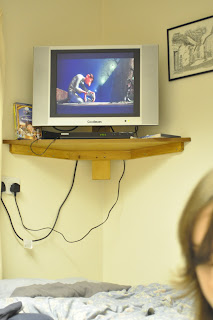During the heavy snowfall in London, I visited Serpentine, Haunch of Venison, Tate Britain, National Portrait galleries and BFI Southbank Centre in London. Here are some ideas I picked up.
June 8, 1968, 2009
Visitors were guided through four rooms/spaces at Philippe Parreno: Films 1987-2010, which included film/animation installations by the artist.
"In Invisibleboy (2010), the viewer is delved deep into a world of both fantasy and reality where the boundaries between fiction and documentary began to blur. The movie features the story of an illegal Chinese immigrant boy who sees imaginary monsters that are scratched onto the film stock. June 8, 1968 (2009) portrays the train voyage that transported the corpse of assassinated senator Robert Kennedy from New York to Washington D.C. Kennedy’s invisible body and the Invisibleboy are characters that float between several layers of reality." [The European Graduate School, 2010]
Serpentine Gallery also was showing Tom Hunter's A Palace for Us, where the artist interviewed residents of Woodberry Down Estate. The film has a documentary style, but the artist re-enacts scenes to narrate their history.
Nicolas Provost also works with moving image, and in his solo show at Haunch of Venison includes Stardust and Storyteller.
And Winter's Bone at BFI Southbank. A daughter searches for her father to avoid the house, where she lives with her younger siblings, from being seized by the court. It's her experience, struggles and interactions with her neighbours and relatives the audience observe.
I've been unable to shoot the ideas I've had, since my checked-in bag has not yet been delivered from Munich airport. My battery charger, a remore timer and my tripod for my camera are all in the bag, and my work continues to be disrupted days after airports managed to clear their runways.
The European Graduate School [2010] Philippe Parreno - Biography. [Online]
http://www.egs.edu/faculty/philippe-parreno/biography/ [26/12/2010]
http://www.egs.edu/faculty/philippe-parreno/biography/ [26/12/2010]
Haunch of Venison [2010] Nicolas Provost: Stardust. [Online]
http://www.haunchofvenison.com/en/#page=london.current.nicolas_provost [26/12/2010]
http://www.haunchofvenison.com/en/#page=london.current.nicolas_provost [26/12/2010]
National Portrait Gallery [2010] Taylor Wessing Photographic Portrait Prize. [Online]
http://www.npg.org.uk:8080/photoprize/site10/index.php [26/12/2010]
http://www.npg.org.uk:8080/photoprize/site10/index.php [26/12/2010]
RoadsideFlix [2010] Winter's Bone - Official US Theatrical Trailer in HD. [Online]
http://www.youtube.com/watch?v=bE_X2pDRXyY [26/12/2010]
http://www.youtube.com/watch?v=bE_X2pDRXyY [26/12/2010]
Serpentine Gallery [2010] Exhibitions: Philippe Parreno: 25 November - 13 February. [Online]
Serpentine Gallery [2010] Tom Hunter: A Palace For Us: 8 December - 20 January. [Online]
http://www.serpentinegallery.org/2009/01/the_skills_exchange_project.html [26/12/2010]
http://www.serpentinegallery.org/2009/01/the_skills_exchange_project.html [26/12/2010]
Tate Britain [2010] Eadweard Muybridge. [Online]












































.jpg)




